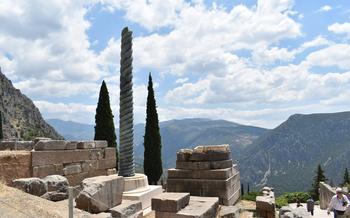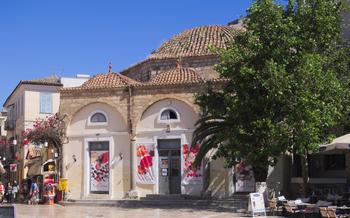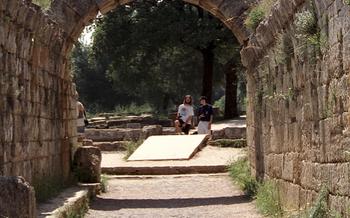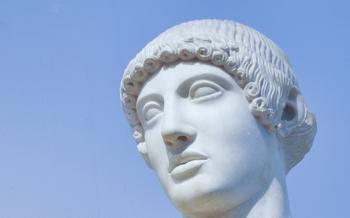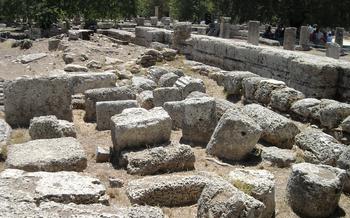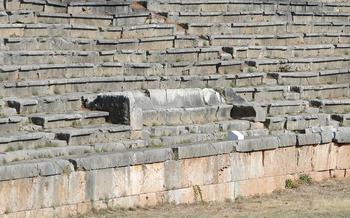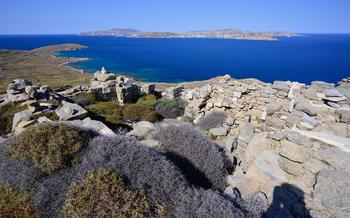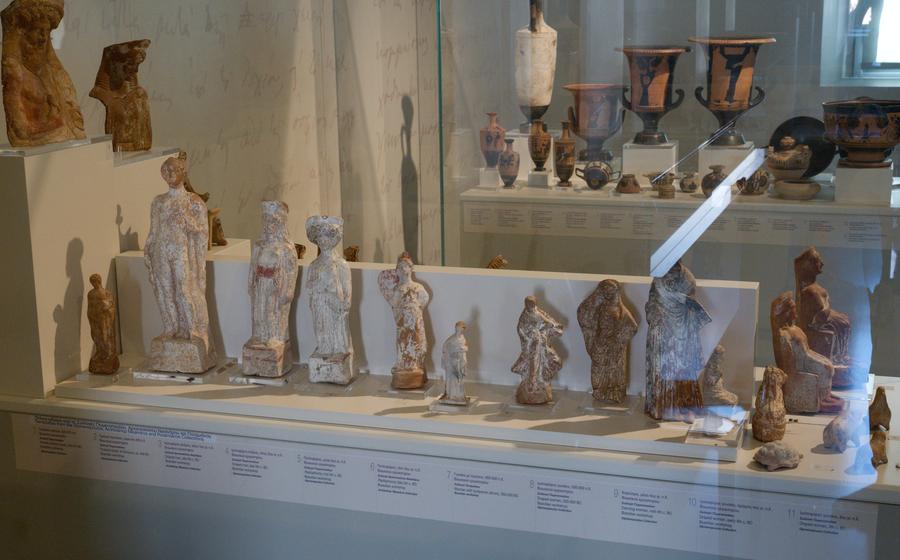
Sanctuary of Asklepios at Epidaurus
- A Journey to Epidaurus: A Sanctuary of Healing and Ancient Marvels
- Tracing the Footsteps of Asklepios: The Healing God
- Exploring the Sanctuary's Enchanting Grounds
- Marveling at the Epidaurus Theater: A Masterpiece of Acoustics
- Unveiling the Tholos: A Symbol of Architectural Ingenuity
- The Stadium: A Testament to Ancient Athleticism
- Design and Structure
- Sporting Events
- Ancient Olympics Connection
- Modern-Day Events
- The Museum of Epidaurus: A Treasure Trove of Antiquities
- Pilgrimage to the Sanctuary: A Journey of Healing and Faith
- The Asklepieia: Ancient Medical Conferences
- The Sanctuary's Enduring Legacy: A Symbol of Healing and Knowledge
- Planning Your Visit: Essential Tips for a Rewarding Experience
- Capturing the Essence of Epidaurus: Photography Tips
- Respecting the Sacred Site: Etiquette and Guidelines
- Insider Tip: Unveiling Epidaurus's Secrets
A Journey to Epidaurus: A Sanctuary of Healing and Ancient Marvels
In the heart of the Peloponnese, nestled amidst rolling hills and verdant landscapes, lies the ancient sanctuary of Epidaurus, a place of profound historical significance and architectural wonders. Renowned throughout the ancient world as a prominent healing center, Epidaurus was dedicated to the revered god of medicine, Asklepios, and attracted countless pilgrims seeking relief from their ailments. The sanctuary's well-preserved ruins stand as a testament to the architectural prowess of ancient Greece, showcasing intricate temples, theaters, and other structures that have earned it recognition as a UNESCO World Heritage Site.
Visiting Epidaurus is a journey through time, where the whispers of ancient healing practices and the echoes of ancient dramas still linger in the air. It's a place where history, myth, and nature intertwine, offering a captivating experience that will leave an enduring mark on your soul. As you explore the sanctuary's enchanting grounds, marvel at the architectural masterpieces, and soak in the healing energy that pervades the atmosphere, you'll discover a place that transcends time and remains a symbol of healing, knowledge, and spiritual connection.
Tracing the Footsteps of Asklepios: The Healing God
In the realm of ancient Greek mythology, Asklepios, the son of Apollo, emerged as the revered deity of healing and medicine. His reputation as a healer was unparalleled, attracting countless pilgrims to the Sanctuary of Epidaurus, seeking relief from their ailments and ailments.
Asklepios's healing abilities were said to be extraordinary. He possessed the power to cure the sick, mend the wounded, and even resurrect the dead. His fame spread far and wide, and people from all corners of the ancient world flocked to Epidaurus, hoping to receive his divine touch.
The sanctuary served as a sanctuary for the sick and injured. Pilgrims would come here to bathe in the sacred springs, offer sacrifices to Asklepios, and sleep in the sacred dormitories, known as the abaton. During their sleep, Asklepios would appear to them in their dreams, revealing the secrets of their healing.
Evidence of these ancient medical practices can still be seen today in the form of votive offerings left by grateful patients. These offerings, which include anatomical sculptures, medical instruments, and inscriptions, provide valuable insights into the medical practices and treatments offered at Epidaurus.
The legacy of Asklepios extends far beyond the ancient world. His teachings and practices have had a profound impact on the development of modern medicine. The Hippocratic Oath, which is still taken by physicians today, is based on the principles of Asklepios and his commitment to ethical medical practice.
Whether you are a history buff, a medical enthusiast, or simply someone seeking a glimpse into the origins of modern medicine, a visit to the Sanctuary of Asklepios at Epidaurus is a journey that will captivate your mind and spirit.
Exploring the Sanctuary's Enchanting Grounds
The Sanctuary of Asklepios at Epidaurus is not just a historical site but also a place of immense natural beauty. Set amidst rolling hills and lush greenery, the sanctuary offers a picturesque backdrop for exploration.
One of the highlights of the sanctuary is its sacred springs. These springs were believed to possess healing properties, and pilgrims would often bathe in their waters or drink from them in the hope of finding a cure for their ailments. Even today, the springs continue to flow, and visitors can still experience their refreshing waters.
Another fascinating aspect of the sanctuary is its collection of ancient inscriptions. These inscriptions provide valuable insights into the history of the sanctuary, the medical practices that were carried out there, and the beliefs of the ancient Greeks. Some of the inscriptions even record the names of patients who were healed at the sanctuary, offering a glimpse into the lives of those who sought solace and healing within its walls.
Ongoing archaeological excavations continue to shed light on the sanctuary's past. New discoveries are constantly being made, and visitors can witness firsthand the work of archaeologists as they uncover the secrets of this ancient site.
Marveling at the Epidaurus Theater: A Masterpiece of Acoustics
The Epidaurus Theater stands as a testament to ancient Greek architectural brilliance, renowned for its exceptional acoustics. Constructed in the 4th century BC, the theater boasts a seating capacity of over 14,000 spectators, yet every whispered word from the stage can be heard clearly even in the farthest rows. This remarkable feat of engineering is attributed to the theater's unique design, which features carefully calculated angles and proportions that amplify and distribute sound evenly throughout the space.
In ancient times, the theater was used for performances of dramas, comedies, and musical events. Today, it continues to host a variety of performances, including ancient Greek plays, concerts, and modern theatrical productions. The theater's acoustics remain as impressive as ever, captivating audiences with their clarity and resonance.
Restoration efforts have been meticulously undertaken to preserve the theater's acoustics and integrity. The original seating arrangements, stage, and orchestra pit have been carefully restored, ensuring that the theater retains its authentic character and functionality.
Attending a performance in the Epidaurus Theater is an unforgettable experience. The combination of the theater's stunning acoustics, picturesque setting, and ancient atmosphere transports visitors back in time, offering a glimpse into the cultural and artistic achievements of ancient Greece.
Unveiling the Tholos: A Symbol of Architectural Ingenuity
Amidst the sprawling grounds of the Sanctuary of Asklepios, the Tholos stands as a testament to ancient Greek architectural prowess and ingenuity. Its circular design, unique among Greek temples, has captivated architects and historians for centuries. Theories abound regarding its function, with some suggesting it served as a treatment center where patients received therapies and consultations. Others posit that it was a place of worship, dedicated to Asklepios or another deity.
The Tholos's intricate carvings and sculptures further enhance its allure. Exquisite depictions of mythological scenes, gods, and goddesses adorn its exterior, inviting visitors to decipher their symbolic meanings. The building's circular shape and intricate ornamentation have led some to speculate that it may have had astronomical or cosmological significance, aligning with the movements of celestial bodies.
Despite the passage of time and the fragmentary nature of the Tholos, its grandeur and beauty remain undiminished. It stands as a symbol of the ingenuity and creativity that characterized ancient Greek architecture, inviting visitors to contemplate its mysteries and marvel at its enduring legacy.
The Stadium: A Testament to Ancient Athleticism
In the heart of the Epidaurus sanctuary, nestled amidst the rolling hills and sacred grounds, lies an impressive testament to ancient athleticism—the stadium. This sporting arena, constructed in the 4th century BC, played a pivotal role in hosting athletic competitions and games that were an integral part of ancient Greek culture.
Design and Structure
The stadium, with its elongated shape, is an exemplary representation of ancient Greek architectural prowess. Its design features a central running track surrounded by stepped seating arrangements that could accommodate up to 20,000 spectators. The starting lines, clearly demarcated at one end of the track, ensured fair and equal beginnings for the athletes.
Sporting Events
The stadium reverberated with the excitement of various sporting events, including footraces, wrestling, and discus and javelin throws. The Epidaurus stadium was particularly renowned for its chariot races, held in a separate section of the stadium dedicated to this exhilarating sport.
Ancient Olympics Connection
The stadium's significance extended beyond the local athletic competitions. It served as a training ground for athletes who aspired to compete in the prestigious ancient Olympic Games, held every four years in Olympia. Victories at Epidaurus were considered a stepping stone to Olympic glory, and many athletes honed their skills and strategies within these ancient grounds.
Modern-Day Events
While the stadium no longer hosts chariot races or ancient Olympic trials, it occasionally serves as a venue for contemporary sporting events and cultural performances. These events, held against the backdrop of the ancient stadium, create a unique and awe-inspiring atmosphere that transports visitors back in time.
The Museum of Epidaurus: A Treasure Trove of Antiquities
Nestled amidst the sprawling grounds of the sanctuary, the Museum of Epidaurus stands as a treasure trove of archaeological wonders unearthed from the sacred site and its surroundings. Its collection paints a vivid picture of life and rituals within the ancient healing center.
Among the museum's prized possessions are exquisite statues and sculptures that once adorned the sanctuary's temples and public spaces. These masterpieces depict gods, heroes, and mythological scenes with remarkable detail and artistry. Visitors can marvel at the serene beauty of Asklepios, the healing god, as well as representations of other deities like Apollo, Artemis, and Aphrodite.
A particularly fascinating section of the museum showcases a collection of ancient medical instruments. These artifacts provide a tangible link to the healing practices that took place at Epidaurus. Visitors can examine surgical tools, probes, scalpels, and other implements that were used by ancient physicians to treat a variety of ailments.
During my visit, I had the privilege of encountering a knowledgeable museum guide who brought the exhibits to life with his captivating stories and insights. He explained the significance of each artifact and its role in the ancient healing rituals. His passion and expertise made the museum experience all the more enriching and memorable.
Pilgrimage to the Sanctuary: A Journey of Healing and Faith
In ancient times, the Sanctuary of Asklepios at Epidaurus was a renowned pilgrimage site, attracting individuals from all corners of the Greek world seeking healing and divine intervention. These pilgrims, often suffering from various ailments and infirmities, embarked on a sacred journey to the sanctuary, believing in the miraculous powers of Asklepios.
Upon arrival, pilgrims would engage in various rituals and ceremonies to honor the healing god. They would offer sacrifices, prayers, and votive offerings, expressing their gratitude and seeking Asklepios's favor. The sanctuary's priests would perform sacred rituals, including purification ceremonies and dream interpretations, to facilitate the healing process.
Accounts of miraculous healings and cures attributed to Asklepios circulated throughout the ancient world, further solidifying the sanctuary's reputation as a place of divine healing. Pilgrims who experienced relief from their afflictions would often leave behind votive offerings, such as small statues or plaques depicting the healed body parts, as a testament to their gratitude and the power of Asklepios.
The sanctuary's reputation as a pilgrimage site extended beyond the ancient world. Even today, Epidaurus continues to attract visitors from around the globe who seek spiritual connection and healing. The sanctuary's enduring significance as a place of pilgrimage speaks to the enduring power of faith and the human quest for healing and well-being.
The Asklepieia: Ancient Medical Conferences
In addition to being a place of healing, Epidaurus was also a hub for medical knowledge and innovation. The sanctuary hosted regular medical conferences known as Asklepieia, which brought together physicians, scholars, and healers from across the ancient Greek world. These conferences provided a platform for the exchange of medical knowledge, ideas, and best practices.
Renowned ancient physicians such as Hippocrates and Galen participated in these Asklepieia, sharing their insights and discoveries. The conferences covered a wide range of medical topics, including diagnosis, treatment, surgery, and pharmacology. Through these gatherings, medical knowledge was disseminated and standardized, contributing to the development of ancient Greek medicine as a respected and influential field.
The Asklepieia played a crucial role in the advancement of medical education and research. They fostered a collaborative environment where physicians could learn from each other, share their expertise, and contribute to the collective body of medical knowledge. The legacy of the Asklepieia can still be felt in modern medicine, as many of the principles and practices developed during these ancient conferences continue to inform contemporary medical thought and practice.
The Sanctuary's Enduring Legacy: A Symbol of Healing and Knowledge
Epidaurus stands as a testament to the remarkable medical achievements of ancient Greece. Its legacy extends far beyond its physical ruins, influencing the development of modern medicine and shaping the ethical principles that guide medical practices today. The sanctuary's recognition as a UNESCO World Heritage Site underscores its universal cultural significance, symbolizing the enduring power of healing and knowledge. Epidaurus continues to inspire and educate, serving as a living testament to the pursuit of health, well-being, and intellectual enlightenment that has transcended time.
Planning Your Visit: Essential Tips for a Rewarding Experience
To make the most of your visit to the Sanctuary of Asklepios at Epidaurus, careful planning is key. The best time to visit is during the shoulder seasons (spring and autumn) when the weather is pleasant, and the crowds are smaller. To fully immerse yourself in the history and significance of the site, consider joining a guided tour. These tours often provide in-depth insights and historical context, enhancing your understanding of the sanctuary.
Getting to Epidaurus is relatively straightforward. From Athens, you can take a scenic two-hour drive along the coastal road or opt for a convenient bus or train journey. If you're driving, remember that parking is limited, so it's advisable to arrive early or park in the designated parking area outside the archaeological site.
Accessibility is a crucial consideration for visitors with disabilities. The sanctuary has made significant efforts to ensure that everyone can enjoy the site. Wheelchair-accessible ramps and designated seating areas in the theater allow visitors with limited mobility to fully participate in the experience.
Planning your itinerary is essential to make the most of your time at the sanctuary. Allocate ample time to explore the various areas, including the theater, the Tholos, the stadium, and the museum. Remember to wear comfortable shoes as you'll be doing a fair amount of walking on uneven surfaces.
Capturing the Essence of Epidaurus: Photography Tips
The Sanctuary of Asklepios at Epidaurus offers a wealth of photographic opportunities, from its awe-inspiring architecture to its picturesque natural surroundings. To capture the essence of this ancient site, consider the following tips:
Lighting conditions: The best time to photograph Epidaurus is during the golden hours, just after sunrise or before sunset, when the warm light casts a magical glow on the ruins.
Composition and angles: Experiment with different angles and perspectives to create visually appealing shots. Capture the grandeur of the theater from the upper tiers, or shoot from a low angle to emphasize the scale of the columns.
Equipment recommendations: A wide-angle lens is essential for capturing the expansive views of the sanctuary. A tripod will help you stabilize your camera for sharp shots, especially in low-light conditions.
Photo spots: Some of the most photogenic spots in Epidaurus include the theater, the Tholos, and the sacred springs. Don't miss the opportunity to capture the stunning views of the surrounding countryside from the upper terraces of the theater.
Respecting the Sacred Site: Etiquette and Guidelines
Epidaurus, as a revered sanctuary and historical site, requires visitors to adhere to certain guidelines and demonstrate respectful behavior. Appropriate attire is essential, with visitors expected to dress modestly and avoid revealing or overly casual clothing. Maintaining a respectful level of noise is crucial to preserve the tranquil atmosphere of the sanctuary. Refrain from engaging in loud conversations or making excessive noise that may disturb other visitors or disrupt the sacredness of the site.
Touching or climbing on ancient structures is strictly prohibited. These structures are delicate and irreplaceable, and any physical contact can cause damage or accelerate their deterioration. Respecting the integrity of these historical artifacts is paramount. Additionally, specific photography restrictions or guidelines may apply at the sanctuary. Be sure to familiarize yourself with these regulations and adhere to them to avoid any inconvenience or potential consequences.
Insider Tip: Unveiling Epidaurus's Secrets
Beyond the well-known attractions, Epidaurus holds hidden gems and secrets that offer a deeper and more immersive experience. One such secret is the hidden chamber beneath the Tholos. This subterranean chamber, accessible through a narrow passageway, was once used for mysterious rituals and ceremonies. Its existence is not widely known, and discovering it feels like uncovering a hidden treasure.
Another secret lies in the theater's exceptional acoustics. While it is commonly known for its remarkable sound quality, there's a fun experiment you can try. From different seating areas, clap your hands or make a sound. You'll be amazed by how the acoustics vary, creating unique auditory experiences depending on your position in the theater.
Finally, consider visiting Epidaurus during the off-season. While the summer months attract larger crowds, the off-season offers a different kind of charm. With fewer visitors, you can enjoy a more intimate and serene atmosphere, allowing you to connect with the sanctuary's ancient energy and tranquility.

